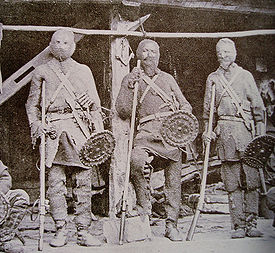
Siege of Geoktepe
Encyclopedia
The Siege of Geok Tepe or The Battle of Geok Tepe was a siege
by the Imperial Russian army
against the Turkmen
fort of Geok Tepe
in 1880-1881.
 After the unsuccessful First siege of Geok Tepe in 1879. The Russians sent a second expedition this time with more men and equipment, including 20,000 camels for transport. In December 1880, Geok Tepe was besieged by 7,100 Russians under General Mikhail Skobelev
After the unsuccessful First siege of Geok Tepe in 1879. The Russians sent a second expedition this time with more men and equipment, including 20,000 camels for transport. In December 1880, Geok Tepe was besieged by 7,100 Russians under General Mikhail Skobelev
against 25,000 defenders. Including the civilian Turkmen population of the area. Learning a lesson from the previous expedition, Skolobev decided to besiege the fort instead of a direct assault.
The siege of Geok Tepe lasted twenty-three days, after which the city was taken by storm. Although they encountered heavy resistance, Russian forces were eventually able to break in by digging a tunnel underneath a portion of the wall, then detonating a mine underneath the wall.
On January 12 (24), 1881, the mine was detonated. Once the fortress was breached, the Russian troops stormed in. Several hundred defenders were killed in the initial explosion, and many more were killed in the fighting that ensued. As the Russians poured in the fort, the defenders, along with the civilians inside the fortress, fled across the desert, pursued by General Skobelev's cavalry.
The Russian general Skobelev
said the following about the massacre:
The battle is remembered as a national day of mourning each year, and the resistance is often cited as a source of great national pride.
Siege
A siege is a military blockade of a city or fortress with the intent of conquering by attrition or assault. The term derives from sedere, Latin for "to sit". Generally speaking, siege warfare is a form of constant, low intensity conflict characterized by one party holding a strong, static...
by the Imperial Russian army
Imperial Russian Army
The Imperial Russian Army was the land armed force of the Russian Empire, active from around 1721 to the Russian Revolution of 1917. In the early 1850s, the Russian army consisted of around 938,731 regular soldiers and 245,850 irregulars . Until the time of military reform of Dmitry Milyutin in...
against the Turkmen
Turkmenistan
Turkmenistan , formerly also known as Turkmenia is one of the Turkic states in Central Asia. Until 1991, it was a constituent republic of the Soviet Union, the Turkmen Soviet Socialist Republic . Turkmenistan is one of the six independent Turkic states...
fort of Geok Tepe
Geok Tepe
Geok Tepe, Gökdepe or Gokdepe, is a former fortress of the Turkmens, in Turkmenistan, in the oasis of Ahal, on the Transcaspian railway, 28 miles north-west of Ashgabat. Gökdepe is the Russian version of the Turkic name meaning "Blue Hill" from the Turkmen gök "blue" and depe "hill" or "summit"...
in 1880-1881.
History

Mikhail Skobelev
Mikhail Dmitrievich Skobelev was a Russian general famous for his conquest of Central Asia and heroism during the Russo-Turkish War of 1877-78. Dressed in white uniform and mounted on a white horse, and always in the thickest of the fray, he was known and adored by his soldiers as the "White...
against 25,000 defenders. Including the civilian Turkmen population of the area. Learning a lesson from the previous expedition, Skolobev decided to besiege the fort instead of a direct assault.
The siege of Geok Tepe lasted twenty-three days, after which the city was taken by storm. Although they encountered heavy resistance, Russian forces were eventually able to break in by digging a tunnel underneath a portion of the wall, then detonating a mine underneath the wall.
On January 12 (24), 1881, the mine was detonated. Once the fortress was breached, the Russian troops stormed in. Several hundred defenders were killed in the initial explosion, and many more were killed in the fighting that ensued. As the Russians poured in the fort, the defenders, along with the civilians inside the fortress, fled across the desert, pursued by General Skobelev's cavalry.
The Massacre
Around 8,000 Turkmen soldiers and civilians, including women and children were killed in their flight, along with an additional 6,500 that were killed inside the fortress. The Russians killed all Turkmen males in the fortress who had not escaped, but they spared some 5,000 women and children and freed 600 Persian slaves. The taking of Geok Tepe and the following slaughter broke the Turkmen resistance and decided the fate of Trancaspia. On May 6, 1881, Transcaspia was declared an oblast of the Russian Empire. During the entire campaign of 1880-1881 Russian casualties were 290 killed and 883 wounded, sickness accounted for the death of 645 Russian soldiers.The Russian general Skobelev
Skobelev
Skobelev can refer to the following people:*Aleksandr Sergeevich Skobelev , Russian writer*Eduard Martsinavich Skobelev, Belarusian politician, writer, poet and playwright*Matvey Ivanovich Skobelev , Russian revolutionary and politician...
said the following about the massacre:
Today
The Geok Tepe (Gokdepe Mosque) was built to commemorate the siege and the defenders, it is noted for its mint-turquoise blue coloured roof and white marble structure.The battle is remembered as a national day of mourning each year, and the resistance is often cited as a source of great national pride.
Further reading
- Chahryar Adle, Madhavan K. Palat, Anara Tabyshalieva History of Civilizations of Central Asia

